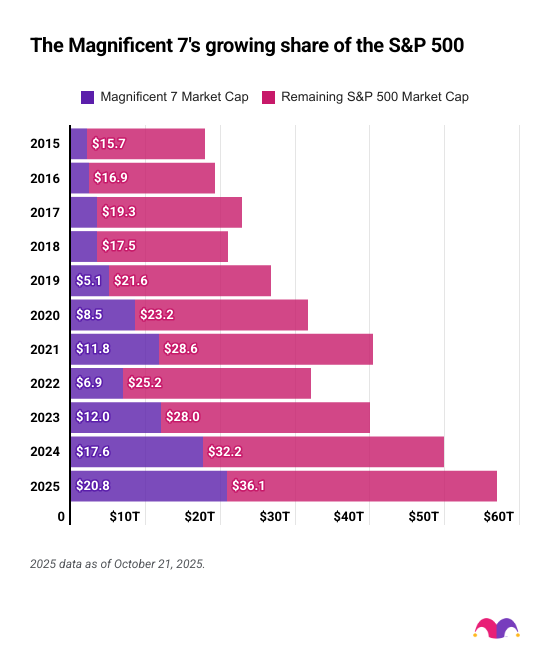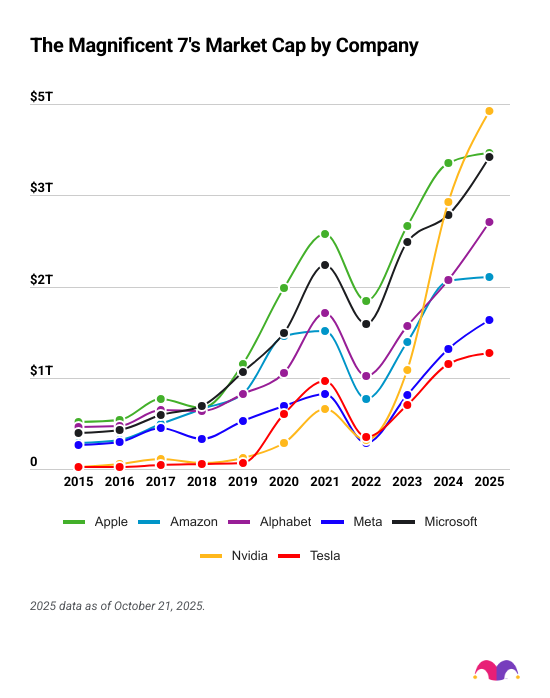
The Magnificent Seven makes up one-third of the S&P 500 – should investors be concerned?
The Magnificent Seven makes up one-third of the S&P 500 – should investors be concerned?
The “Magnificent Seven” companies now make up nearly a record 37% of the S&P 500’s total market capitalization and have consistently outperformed the index. But that growing concentration raises questions for investors. While those seven tech giants have driven jaw-dropping returns, their dominance increases downside risk and volatility.
The "Magnificent Seven" are a group of seven of the largest and most influential technology-focused companies: Apple, Amazon, Alphabet (formerly Google), Meta, Microsoft, Nvidia, and Tesla.
All of these companies have grown rapidly over the last decade, and they all currently have a market cap of more than $1 trillion.
The Motley Fool shares how the Magnificent Seven has reshaped the S&P 500 and what it means for investors.
The Magnificent Seven’s Growing Share of the S&P 500
The Magnificent Seven account for 37% of the S&P 500 as of Oct. 21, 2025. That's close to three times as much as in 2015, when they made up 12% of the S&P 500 — an unprecedented level of growth among a handful of stocks.

The S&P 500 performed very well from the end of 2015 through 2024, with an overall return of 178%. However, it doesn't come close to the Magnificent Seven, which had a 698% combined return over that same time span. That’s a reflection of not only the tech sector’s outsized importance in the global economy but of how concentrated growth within the tech sector has been in the last decade.
From 2015 through 2024, the Magnificent Seven soundly outperformed the S&P 500. The group delivered higher returns in eight out of nine years. The biggest difference was in 2020, when the Magnificent Seven had an annual return more than three times higher than the S&P 500 (66% to 18%).
While the Magnificent Seven have delivered strong returns, particularly during bull markets, their tech-heavy, growth-centric orientation makes them less resilient to downturns compared to the well-diversified S&P 500. The only year in which the S&P 500 outperformed the Magnificent Seven was 2022, when it fell 20% and the Magnificent Seven declined 41%. Most recently, the S&P 500 recovered more quickly than the Magnificent Seven from the stock market sell-off in April.
However, the Magnificent Seven have since pulled ahead in year-to-date performance with returns of 19% compared to the S&P 500 at 15%, in part due to artificial intelligence (AI) fueling their growth.

Each company's contribution to the Magnificent Seven has changed since 2015, with some growing more significantly than others.
- Nvidia has been the top performer after adding nearly $4.4 trillion to its market cap since the end of 2015. It went from being the smallest contributor to the Magnificent Seven, at just 0.8% of the group’s combined value, to the largest at 21.2%.
- Apple, which spent much of the last decade as the largest company measured by market capitalization, was dethroned by Nvidia.
- Alphabet, the holding company that owns Google, has fallen the most within the group. It dropped two places, from second to fourth. Being the worst performer among the Magnificent Seven is all relative — Alphabet has still multiplied its market cap and outperformed the S&P 500.
- Microsoft has remained the third-largest Magnificent Seven company by market capitalization, although it's gaining ground on Apple.
- Amazon, Meta, and Tesla have each dropped by one position in the hierarchy to fifth, sixth, and seventh, respectively.
What the Magnificent Seven Dominating the S&P Means for Investors
Investors who buy S&P 500 index funds sometimes worry about how top-heavy the index has become — a fair concern given that seven companies contribute more than a third of the S&P 500's value.
These companies make up such a large portion of the S&P 500 because of their outsized success in recent years. Anyone invested in the S&P 500 has shared in those returns, so there are advantages to the Magnificent Seven's dominance.
However, the Magnificent Seven don’t come without risks. The group is concentrated in one sector, technology, and is more volatile than the S&P 500. As a result, they’re more heavily impacted by downturns and can drag down the performance of the entire S&P 500.
Of course, it's also possible that the Magnificent Seven will continue their success and deliver outsized returns to investors who hold for the long term. And even if some of the Magnificent 7 falter, others may rise to take their place
Despite the Magnificent Seven accounting for increasingly more of the S&P 500’s market capitalization, S&P 500 index funds are still a simple, effective way to invest in a diversified basket of stocks. Continuing to track how much of the S&P 500’s performance is driven by the Magnificent 7, however, is becoming more important in determining the best course for portfolio construction.
This story was produced by The Motley Fool and reviewed and distributed by Stacker.



